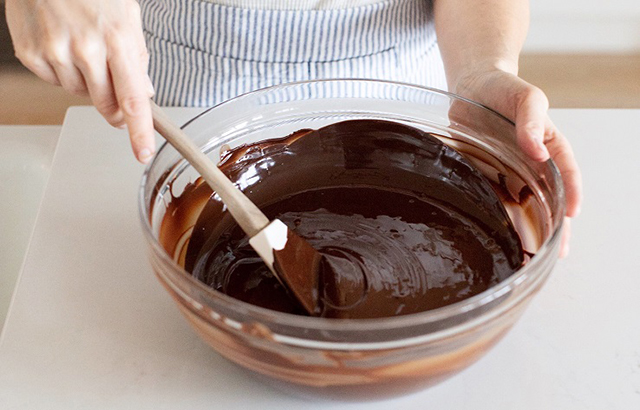
The most common issues with chocolate tempering can be solved with these tips and tricks. Having trouble tempering chocolate? When working with chocolate, one of the most common inquiries is, “Why is my chocolate not tempering properly?” Our tips and tricks will help you troubleshoot common chocolate tempering problems.
Working with chocolate can be incredibly frustrating, and no one knows that better than us! It is literally temperamental. It’s extremely sensitive to changes in temperature, humidity/moisture, agitation, etc. etc.! You believe that everything is going according to plan and that you are tempering chocolate correctly, but then you realize that everything has seriously gone wrong. There is a lot of science that goes into tempering chocolate properly, and you can save yourself a lot of frustration by understanding why your chocolate isn’t tempering properly and how to troubleshoot common tempering problems.
For a quick reminder about what tempering is, why we have to temper chocolate, and how to temper chocolate click here.
The most crucial skill for a chocolatier or chocolate maker is the ability to temper chocolate. It’s likely something that you will have to practice many times before you are successful. Once you have the money to invest in your business or hobby, you will likely buy a tempering machine that will make your life infinitely easier. BUT, having said machine doesn’t mean that you don’t have to learn how to temper. It’s not just about the end result when you learn how to temper chocolate. It’s about making sure that you understand the process – the chemistry involved, the steps involved, what you’re looking for, and why.
Tips for troubleshooting chocolate tempering
With that said, there are some common issues that may explain why your chocolate isn’t tempering properly.
Control the air temperature and humidity in your work area. If it was warmer or cooler in the room during your practice session, then you will have to adjust for the change in room temperature in how you temper. For example, the amount of seed needed in the seeding method; reduction of the temperature by making the cool water bath or marble slab a little colder; keeping the warm water bath stable when you try to maintain the temper. Too much humidity or too dry a climate also can affect temper. Yes, humidity control and air conditioning will be essential to your commercial operation. The ideal temperature for working with chocolate in a kitchen or production area is 64-70°F (18-21°C), with 50-65% humidity.
Check your thermometer
As you are checking very minuscule temperature changes from one degree to the next, you need to make sure your equipment is used properly and functioning correctly. You will want to take the temperature after stirring the chocolate mass thoroughly (not when it has been sitting for a while, as a thick mass will develop hot and cool spots).
Keep stirring/agitating the chocolate mass as you temper
Did you continually stir the mass throughout the process? If you leave it on the slab or in the bowl without stirring, you run the risk of the part of the mass that is up against the cool marble slab solidifying. Or the chocolate up against the hot bottom of the bowl falling out of temper because it gets too hot. Again, since we are talking about differences of only one or two degrees, you have to be careful with the process.
Be careful about introducing bubbles of air into your chocolate mass
To avoid introducing air, which will result in the formation of air bubbles, carefully stir or agitate using a pull or push motion rather than a whipping motion. These bubbles can be a big problem when you are molding. And be aware that air bubbles happen more readily if you are tempering a non-couverture chocolate i.e. one with a higher viscosity. Always investigate the chocolate’s viscosity to determine whether it will work better for enrobing or molding (more fluid) or ganache (more viscous).
Don’t over-temper or over-seed your mass of chocolate
As you stir the chocolate mass over time at the working temperature, you create more V-form crystals which makes the chocolate mass thicker until it’s hard to work with, even though it’s still in temper. To combat this you need to melt some of the excess V-form crystals by either:
the addition of warm chocolate at 115° F (47° C). Be careful not to raise the temperature of the whole mass too much as you do this because that will throw the chocolate out of temper.
or heating the edges of the chocolate mass with a heat gun or over hot water. Make sure you thoroughly mix the warmed chocolate into the mass.
Are you beginning to see what we mean when we say that chocolate is temperamental? Wait a minute, there’s more! Don’t shock your chocolate (it doesn’t like to be surprised)!
Fat bloom can occur when the center you are enrobing is too cold or has moisture on it. It can also occur from putting the enrobed centers into the fridge too long where, again, cold and moisture can promote fat or sugar bloom.
Do a temper test
Before using the mass of tempered chocolate for enrobing or molding, place a small blob of tempered chocolate on a utensil, parchment or acetate – it should harden within minutes. As you work with the chocolate during your enrobing or molding session, don’t forget to periodically conduct a second temper test and agitate the tempered chocolate mass. Ok, you’ve finished an unsuccessful tempering session, now what do you do with a mass of untempered chocolate?
You can re-temper the chocolate over and over again. The only downside is increased viscosity, IF (and that is a big IF) in an earlier session you haven’t overheated the chocolate to the point of possibly burning and IF you haven’t gotten any foreign substance in it, such as water, ganache or nut bits. If you think the mass was compromised in any way, start your next tempering session with new chocolate. You can use the compromised mass for recipes such as ganache or truffle centers so it isn’t wasted.
When you’re finished working, pour out the tempered chocolate onto parchment or acetate and let it harden for storage. One of our students pours her excess tempered chocolate into a plastic zipped storage bag, seals the top then flattens it out to harden. The flat shape is very easy to store and when you need it, you simply break up in pieces in the bag then pour back into your tempering machine or bowl to melt.
When the chocolate has been tempered, why does the mass sometimes harden with bloom? A large mass of tempered chocolate can become untempered when the heat from the center of the mass can’t dissipate as you aren’t agitating it anymore. So it retains the heat in the center and cools slowly. The latent heat of crystallization is to blame for this. As chocolate is crystallizing it gives off heat (an exothermic reaction) and can get warm enough to throw itself out of temper. This issue with latent heat is also why it is important to cool pieces when they are rapidly crystallizing. Putting your mold, or your dipped piece, into a well ventilated refrigerator as soon as you see signs of it starting to crystallize around the edges for 15 minutes or so will carry off that latent heat and prevent the pieces from throwing themselves or each other out of temper.
In that slow process of cooling, some of the cocoa butter molecules release and rise to the surface or get trapped in layers. If this occurs, don’t worry. You are going to have to heat the mass again to either temper it or use it in a recipe. This will mix the cocoa butter back into the mass.
To temper untempered chocolate again, you need to melt and solidify all of the unstable crystals that were formed. Heat the mass of untempered chocolate to at least 115° F (46° C) for dark chocolate and to 110° F (44° C) for milk or white chocolate.
Note that a slight hint of bloom can also happen if you are molding very thick bars, suckers or 3D shapes and don’t cool them quickly. The molded side will be fine, shiny and tempered. But the exposed part of the chocolate may have very light rings or speckles – which may or may not be a problem for you. You can overcome this problem by experimenting with using layers of chocolate to fill the mold instead of just one pour.
Absolutely Important Note: Please check the chocolate manufacturer’s tempering specifications for the chocolate you are using. That information can be found on the package or the manufacturer’s website.










